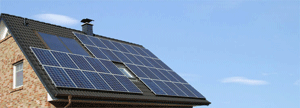Two recent eye-opening announcements prove that renewable energy is no longer at the mercy of the price of oil.
Both involve solar power, which I find increasingly attractive in today's markets.
The first is a major test of a joint project between Tesla Motors Inc. (Nasdaq: TSLA) and SolarCity Corp. (Nasdaq: SCTY) involving 500 California homes.
Sources have told me they expect this test to be the final "proof of concept," followed by wider applications in both residential and commercial uses.
 The lynchpin between the two is a family connection.
The lynchpin between the two is a family connection.
Tesla's CEO is Elon Musk, one of the most innovative entrepreneurs of our time, while his cousin Lyndon Rive is the CEO of SolarCity. Musk is also SolarCity's biggest shareholder.
Now the two are coming together in hopes of solving the industry's biggest roadblock...
Solar Power Comes of Age
Tesla, of course, needs very little introduction. The California-based company has a very visible position in cutting-edge electric cars.
SolarCity, on the other hand, is the market leader in installations. In the third quarter of 2014, SolarCity led the pack in this portion of the business by grabbing 39% of the market. Meanwhile, SolarCity's next-closest competitor came in at 16%.
The two market leaders are now combining some of their operations in a very serious attempt to bring solar power into more consumer areas. In short, SolarCity is working with Tesla to make rooftop panels that are fitted with Tesla batteries.
Now a major test is underway in California that may usher in a new age of residential solar battery use.
The California test will utilize a solar battery with the ability to power a home for two days in the event of a blackout. In everyday use, the unit is expected to allow homeowners to store solar-generated power for use during high-cost periods, giving them the flexibility to use the conventional grid for cheaper, off-peak electricity.
Storing generated power for use at other times - in short, perfecting a new line of cost-effective batteries - has been the industry's single biggest hurdle.
So the California residential test may well usher in a whole new ballgame. Considering the batteries from the Tesla-SolarCity venture (involving more than the California test) utilize a new generation of silicon batteries, rather than relying on rare earth metals or lithium, is also a plus. This type of approach is already well advanced, and is based on considerable familiarity and history.
It also doesn't hurt that Tesla is building the biggest battery factory on the planet right now. Dubbed the "Gigafactory," the plant is expected to have a dramatic effect on the energy storage market, helping to bring battery costs down by as much as half by 2020.
So while the initial price of these installations may come in high, as with any generation-changing new technology, the cost will eventually come down. What's more, there may be some credits and other inducements provided by the companies to stimulate usage.
This development, combined with the recent decisions by Apple Inc. (Nasdaq: AAPL) to power its new Pentagon-like headquarters via solar and Google Inc. (Nasdaq: GOOG) opting for wind power for its San Francisco Bay Area base, show that renewables are now moving into all aspects of electricity end use here in the States.
India Breaks Ground on the World's Largest Solar Plant
The second major development for renewables is unfolding halfway around the world.
India has announced a major push to provide 15% of its electricity needs from renewables with an initial push into solar power, which is unfolding right now. It's the first high-profile effort to provide concrete plans for a major Asian advance into solar power distribution.
The Times of India reported on Feb. 16 that the construction of the world's largest solar power plant has begun in the central Indian Rewa district, within the state of Madhya Pradesh. The plant, a joint venture between state-run PSU Urja Vikas Nigam and the Solar Energy Corp. of India, will provide 750 megawatts of electricity. Once online, the plant will be 36% bigger than the largest plant currently in operation.
The current world leader is the 550-megawatt Desert Sunlight Solar Farm, which just opened in California's Mojave Desert. Situated on 3,800 acres near Joshua Tree National Park, the plant produces enough energy to power 160,000 homes.
[epom key="ddec3ef33420ef7c9964a4695c349764" redirect="" sourceid="" imported="false"]
But the Indian push into solar power hardly ends there. The government has plans for two dozen solar farms strategically placed throughout the country.
In all, the State Bank of India has committed resources for the development of 15 gigawatt of solar power by 2020. The objective is to provide a full 15% of the nation's energy needs from renewable sources within five years.
To be sure, there are some doubts that New Delhi can pull this off. For one thing, the price tag is very debatable. For another, the national electricity distribution grid is in a sorry state, and would require significant, pricey, and (at the moment) an unspecified amount of investment to be able to shoulder the anticipated new power load.
Still, with the Chinese committed to a similar 15 gigawatt goal from solar by 2020, Germany's decision to end its reliance on nuclear power, and the continued growth pattern in the United States, one conclusion is already abundantly clear.
The future of solar, wind, biomass, geothermal, and other renewables is no longer dependent on the price of crude.
Wrong Again! Citigroup analyst Ed Morse just came out with his most bearish forecast yet, claiming oil prices could fall to $20 a barrel. The market, of course, has ignored these concerns, as crude oil prices continue to climb. Here's the one glaring problem with all of this bearish analysis...
About the Author
Dr. Kent Moors is an internationally recognized expert in oil and natural gas policy, risk assessment, and emerging market economic development. He serves as an advisor to many U.S. governors and foreign governments. Kent details his latest global travels in his free Oil & Energy Investor e-letter. He makes specific investment recommendations in his newsletter, the Energy Advantage. For more active investors, he issues shorter-term trades in his Energy Inner Circle.



